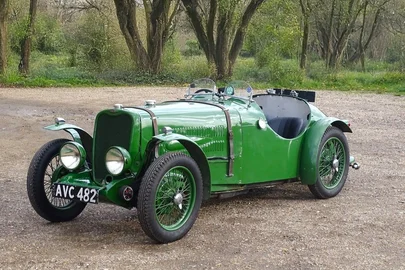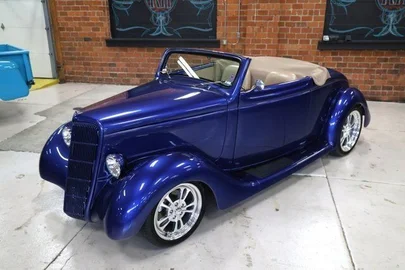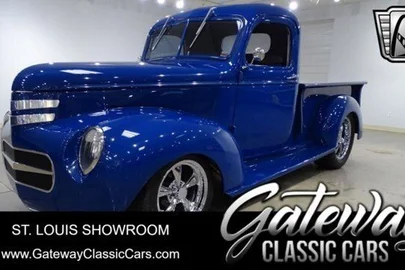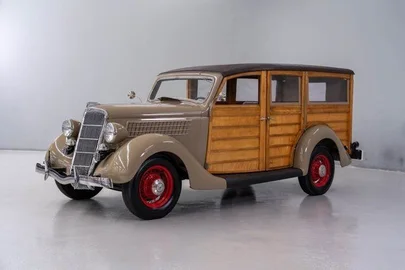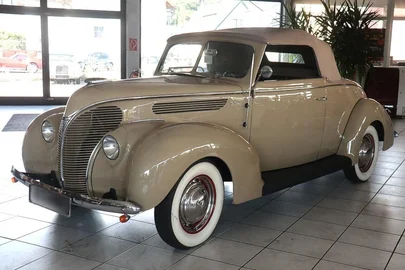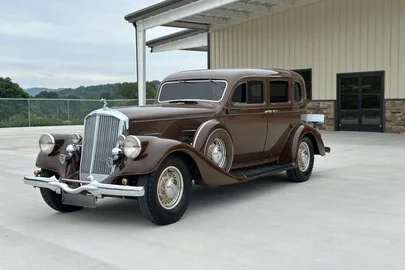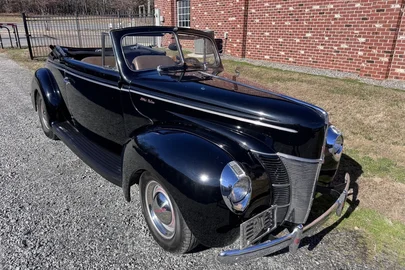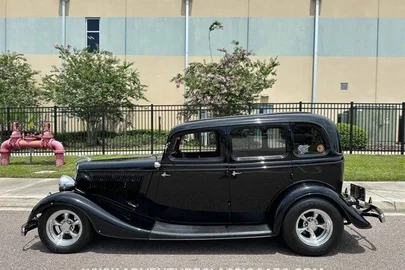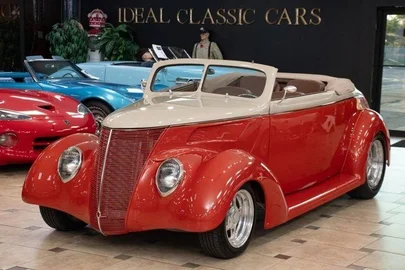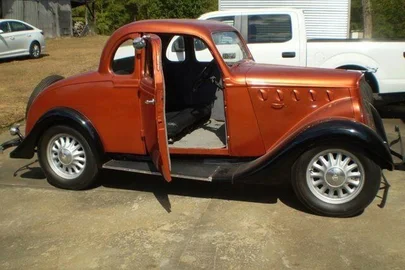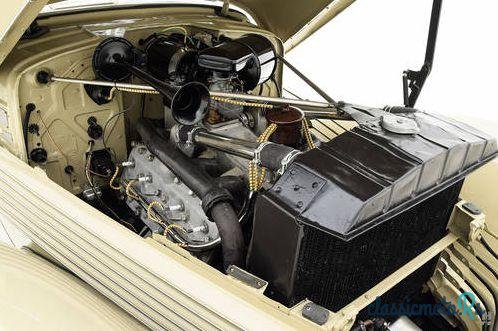
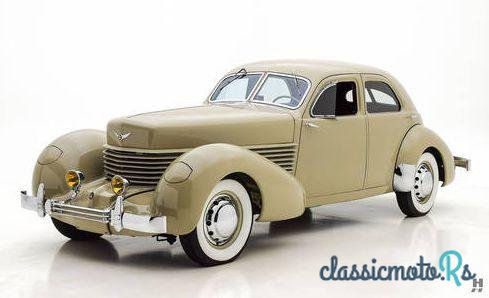
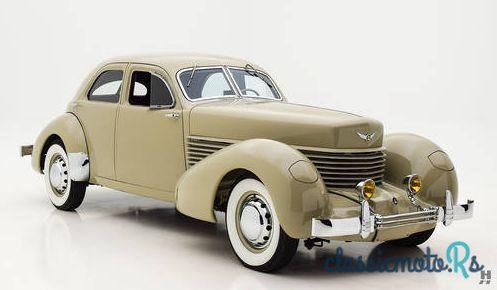
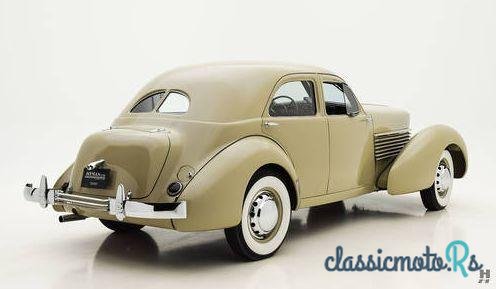
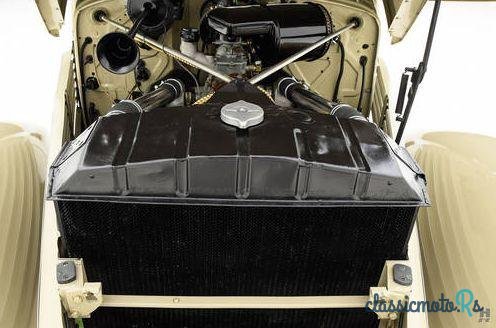
5 foto
1937' Cord 812
Diese Anzeige melden!Bewerte!Lesezeichen setzen
$69,500Veröffentlicht 25 Juni 2017ID: uKW6Q0
Abgelaufen
8 Jahre, 6 Monate her
8 Jahre, 6 Monate her
Information from the owner
Karosserie: Sedan
Alter: 80 Jahre
Außenfarbe: Weiß
Außenseite: Nebelscheinwerfer
Verkäuferkommentare zu 1937' Cord 812
At first glance, the Cord 810/812 may not seem like a car born of the Great Depression. But during those anxious years, high end manufacturers were struggling to sell extravagant machines, as even the most wealthy of buyers shied away from flaunting their status quite as openly in public. Many manufacturers resorted to developing lower priced models to make up sales. Packard developed the Junior series, Lincoln added the Zephyr line and GM introduced LaSalle to fit between Buick and Cadillac. Even Duesenberg wasn’t immune to the pressure and work was begun on a “baby” Duesenberg that could help pick up sagging sales. Partially through its development, the baby Duesenberg idea was dropped, as it was thought it could tarnish the illustrious brand. But E.L. Cord, the man in charge of Auburn-Cord-Duesenberg, saw great potential in the design and pressed forward to produce it as an all-new model for his revived Cord brand. The Cord L-29 had been out of production for some time, and E.L. saw this as an opportunity to revive the brand that bore his name.
Development of the new car forged ahead and the Cord 810/812 was realized by 1936. In spite of its “entry level” roots, technical boundaries were pushed to the limits. Drawing inspiration from the innovative Citroen Traction Avant, Cord designer Gordon Buehrig gave the 810 a semi-monocoque chassis, and it was the first American car with both front wheel drive and independent front suspension. Motivation was courtesy of a Lycoming V8 engine (Lycoming being part of E.L. Cord’s industrial empire) and a solenoid actuated pre-selector transmission. Of course the most distinguishing feature of the 810/812 was its Gordon Buehrig-penned bodywork. The front end featured curvaceous fenders with hidden headlights – a first for any production car. Rather than a traditional radiator shell, the Cord’s radiator was hidden behind a sleek and unorthodox wraparound grille and a uniquely shaped hood, which earned it the nickname “Coffin Nose”. Fully extended doors, no running boards and a sleek, minimally adorned body gave the 810 its distinct appearance. Nearly 80 years later, the Cord 810/812 is still considered to be one of the greatest American car designs in history.
As the 810 evolved into the 812 for 1937, some models gained a supercharger, while others remained naturally aspirated. Several body styles were available, from four-door sedans to the open-air phaeton. In fact, several four door versions were available with different designations depending on wheelbase, equipment and body fitments. At the “entry level” lay the Westchester, followed by the Beverly, Custom Beverly and range-topping Berline, the latter two riding on an extended wheelbase. The most distinguishing feature between the Westchester and Beverly was the addition of a “bustle” trunk on the on the Beverly. It also offered more luxurious trappings inside, with additional trim and equipment. The Beverly rode on a 125” wheelbase and shared the same 288 cubic inch Lycoming V8 and sophisticated preselect transmission with the rest of the model range.
This fine 1937 Cord 812 Beverly Sedan is an attractive, usable example of one of the most iconic American automobiles of all time. Coming out of recent long-term ownership, it wears an older restoration that has been well-maintained and presents in very good order, showing some light patina in areas, remaining mechanically and cosmetically very sound. It is finished in Palm Beach Tan, with very good paintwork applied over straight and properly aligned panels with excellent, consistent gaps. During a time when cars were defined by their prominent chrome radiator shells and trim, Gordon Buehrig eschewed the flash in favor of a subtle, measured design with limited chrome adornment. That said, bumpers, wheel covers and door handles provided some subtle flash, all of which appear in very good order on this example. The bumpers, wearing original overriders, are straight and tidy with good quality plating and detail. A pair of period-correct Cord fog lamps is fitted to the front apron and the original polished stone guards remain in good order on the rear fenders.
The interior presents in very good order, again, well detailed and tidy though showing some patina from use since the restoration was completed. Plum-colored upholstery piped in off white complements the Palm Beach Tan body color quite well. The seats, door panels and headlining remain in very good condition with quality trim accented with very good chrome fittings and hardware. Cord’s signature instrument panel is beautifully presented with its aeronautic-style engine-turned fascia and an array of dials keeping the driver informed of underhood matters. A very cool period Motorola heater is fitted, presumably from new.
The 288 cubic inch Lycoming V8 engine and undercarriage are tidy, appearing sorted and well-maintained. The specification and condition of this 812 Beverly should lend it very well to touring, and thanks to the Cord 810/812’s recognition as a CCCA Full Classic, it is eligible for CARavan touring and is well suited to regular enjoyment. The Cord 812 is an icon of American design and this is a good quality, usable example that has benefitted from long term ownership and care.
$69,500
stock number 5926
For immediate assistance please call us at +1-314-524-6000
Development of the new car forged ahead and the Cord 810/812 was realized by 1936. In spite of its “entry level” roots, technical boundaries were pushed to the limits. Drawing inspiration from the innovative Citroen Traction Avant, Cord designer Gordon Buehrig gave the 810 a semi-monocoque chassis, and it was the first American car with both front wheel drive and independent front suspension. Motivation was courtesy of a Lycoming V8 engine (Lycoming being part of E.L. Cord’s industrial empire) and a solenoid actuated pre-selector transmission. Of course the most distinguishing feature of the 810/812 was its Gordon Buehrig-penned bodywork. The front end featured curvaceous fenders with hidden headlights – a first for any production car. Rather than a traditional radiator shell, the Cord’s radiator was hidden behind a sleek and unorthodox wraparound grille and a uniquely shaped hood, which earned it the nickname “Coffin Nose”. Fully extended doors, no running boards and a sleek, minimally adorned body gave the 810 its distinct appearance. Nearly 80 years later, the Cord 810/812 is still considered to be one of the greatest American car designs in history.
As the 810 evolved into the 812 for 1937, some models gained a supercharger, while others remained naturally aspirated. Several body styles were available, from four-door sedans to the open-air phaeton. In fact, several four door versions were available with different designations depending on wheelbase, equipment and body fitments. At the “entry level” lay the Westchester, followed by the Beverly, Custom Beverly and range-topping Berline, the latter two riding on an extended wheelbase. The most distinguishing feature between the Westchester and Beverly was the addition of a “bustle” trunk on the on the Beverly. It also offered more luxurious trappings inside, with additional trim and equipment. The Beverly rode on a 125” wheelbase and shared the same 288 cubic inch Lycoming V8 and sophisticated preselect transmission with the rest of the model range.
This fine 1937 Cord 812 Beverly Sedan is an attractive, usable example of one of the most iconic American automobiles of all time. Coming out of recent long-term ownership, it wears an older restoration that has been well-maintained and presents in very good order, showing some light patina in areas, remaining mechanically and cosmetically very sound. It is finished in Palm Beach Tan, with very good paintwork applied over straight and properly aligned panels with excellent, consistent gaps. During a time when cars were defined by their prominent chrome radiator shells and trim, Gordon Buehrig eschewed the flash in favor of a subtle, measured design with limited chrome adornment. That said, bumpers, wheel covers and door handles provided some subtle flash, all of which appear in very good order on this example. The bumpers, wearing original overriders, are straight and tidy with good quality plating and detail. A pair of period-correct Cord fog lamps is fitted to the front apron and the original polished stone guards remain in good order on the rear fenders.
The interior presents in very good order, again, well detailed and tidy though showing some patina from use since the restoration was completed. Plum-colored upholstery piped in off white complements the Palm Beach Tan body color quite well. The seats, door panels and headlining remain in very good condition with quality trim accented with very good chrome fittings and hardware. Cord’s signature instrument panel is beautifully presented with its aeronautic-style engine-turned fascia and an array of dials keeping the driver informed of underhood matters. A very cool period Motorola heater is fitted, presumably from new.
The 288 cubic inch Lycoming V8 engine and undercarriage are tidy, appearing sorted and well-maintained. The specification and condition of this 812 Beverly should lend it very well to touring, and thanks to the Cord 810/812’s recognition as a CCCA Full Classic, it is eligible for CARavan touring and is well suited to regular enjoyment. The Cord 812 is an icon of American design and this is a good quality, usable example that has benefitted from long term ownership and care.
$69,500
stock number 5926
For immediate assistance please call us at +1-314-524-6000
